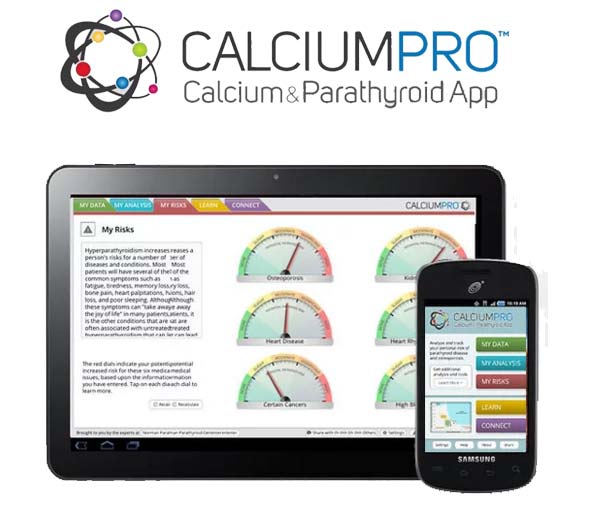Diagnosing Parathyroid Disease

Primary hyperparathyroidism (pHPT) is a destructive disease that causes osteoporosis, kidney damage, and it increases the risk of heart attack and stroke. Surgery is the only cure for pHPT. Unfortunately, delays in the diagnosis and treatment of pHPT are common.
For most, only two parathyroid tests are needed to establish or exclude the diagnosis of pHPT: serum calcium and parathyroid hormone (PTH) levels. These parathyroid tests should be checked at the same time. In “classic” pHPT, both the calcium and PTH levels are high.
Unfortunately, it is very common to undergo a slew of parathyroid tests and parathyroid scans, resulting in unnecessary costs and delays in treatment. Such expenses go beyond the expensive price tag of the parathyroid tests, including the time required to undergo parathyroid scans, the negative impact on quality of life from living with pHPT, and the cost of avoidable health complications due to treatment delay.
Diagnosing Parathyroid Disease
Five Common Pitfalls to Avoid When Diagnosing Parathyroid Disease
- The 24 Hour Urine Calcium Test Leads to Uncertainty and Delay
- Parathyroid Scans Cannot Be Used to Diagnose or Exclude pHPT
- Many People with “Normal” PTH Levels Have pHPT
- The Vitamin D Fake Out
- Parathyroid Test Results Often "Jump Around” in pHPT
1. The 24 Hour Urine Calcium Test Leads to Uncertainty and Delay
Ms. O. was a 73-year-old woman from Florida who was incidentally found to have a high serum calcium level of 10.6 mg/dL. Her calcium levels were normal in previous years. Subsequent parathyroid testing revealed an inappropriately high PTH level in the context of a consistently high calcium level. A 24 hour urine calcium excretion test was very low at 21 mg/day. The patient was told that she had familial hypocalciuric hypercalcemia (FHH). The diagnosis of pHPT was made several years later, but only after the she developed osteoporosis and coronary artery disease.
The 24 hour urine calcium excretion test requires that you collect all urine during the day and night in a bottle, which you store in your kitchen refrigerator, and then transport it immediately to the lab. It’s an inconvenient and unpleasant test that is not necessary for those with new onset high calcium and high PTH levels.
This not a useful parathyroid test to diagnose pHPT, because people with parathyroid tumors can have low, medium, or high urine calcium levels. Additionally, people with new onset high calcium and high PTH levels, do not have FHH.
FHH is an extremely rare disease that runs in families which is associated with a higher than normal amount of calcium in the blood and a lower than normal amount of calcium in the urine. People with FHH have high calcium levels their entire lives, and they do not need to be treated.
If you have NEW onset high blood calcium and a high PTH level: 1) you have pHPT; 2) FHH should not be considered; and 3) there is no role for a 24 hour urine calcium test.
2. Parathyroid Scans Cannot Be Used to Diagnose or Exclude pHPT
Mrs. S is a 77-year-old woman from Canada who presented with “brain fog” and was found to have a serum calcium level of 10.9 mg/dL. Subsequent testing revealed a high PTH level in the context of consistently high blood calcium, high urine calcium excretion, and bone loss. She underwent a sestamibi parathyroid scan, a CT parathyroid scan, and an ultrasound parathyroid scan. None of these parathyroid scans were able to locate a parathyroid adenoma. She was told that she did not have pHPT. The diagnosis of pHPT was made several years later, only after she developed kidney stones.
If you feel a breast lump in the shower, a scan can be used to determine if a breast tumor is present. Similarly, if you cough up blood, a scan can be used to determined if a lung tumor is present. Under both circumstances, if the appropriate scans are negative, you can rest assured that you do not have a tumor.
However, when pHPT is suspected, a negative parathyroid scan cannot be used to exclude a parathyroid tumor. This is because parathyroid scans lack sensitivity. In other words, it is common for parathyroid tumors to be undetectable on parathyroid scans.
Furthermore, a positive parathyroid scan cannot be used to make the diagnosis of pHPT. This is because the specificity of parathyroid scans is not great. In other words, when a parathyroid scan shows a candidate tumor, sometimes this is a fake out (e.g., thyroid nodule or lymph node).
Overall, when someone has high calcium and PTH levels, the diagnosis of pHPT is clear, and parathyroid scans do not add diagnostic value. Furthermore, parathyroid scans should not be used to determine who should be referred to a surgeon.
3. Many People with “Normal” PTH Levels Have pHPT.
Ms. T is 70-year-old woman from Florida who was incidentally found to have a high serum calcium level of 10.7 mg/dL on routine labs. Subsequent testing revealed a PTH level of 52 pg/mL (reference range 15-77 pg/mL). Her primary care provider informed her that her parathyroid test results were normal. Unfortunately, the diagnosis of pHPT was made several years later, only after she developed osteoporosis.
Some lab tests give a straightforward “positive” or “negative” result. However many tests, including the PTH test, give continuous numbers that are not meaningful by themselves. Rather, their meaning comes by comparing it to reference values.
Lab companies provide a “reference range”, which are typical values seen in the population that they have tested. Most test results follow a “normal distribution” (also known as a “bell-shaped curve”), and the reference range reflects this. Interestingly, the reference range for PTH will vary, depending on which company performed the test.
Some lab reports will say “reference range”, but others will list “reference” or “range” on the document. You almost never see the phrase “normal range” on a lab report, although most use this term interchangeably when they communicate lab results.
Many people with pHPT have PTH results within the “normal” range. In our Hospital for Endocrine Surgery, where patients typically turn to us for an expert second opinion (so perhaps a lower percentage of “straightforward” cases), approximately 25-30% of patients will have “normal” PTH levels.
Although there are multiple reasons for having high calcium, virtually all of these are associated with a LOW PTH level. Parathyroid glands, like every gland in the human body, must have the ability to turn-off when its downstream effect is too high. Analogous to a thermostat that must turn off the heating system when the temperature is too hot in a room, normal parathyroid glands turn off when the blood calcium level is too high.
If you have new onset high calcium and PTH levels that do not turn off appropriately, pHPT is your problem.
4. The Vitamin D Fake Out
Mr. F. is a 63-year-old man from Illinois who was incidentally found to have a high serum calcium level of 10.4 mg/dL on routine labs. Subsequent parathyroid tests revealed a high PTH level of 92 pg/mL, consistently high calcium, and a low vitamin D25OH level of 21 pg/mL. He was diagnosed with vitamin D deficiency and given high doses of vitamin D. He was eventually diagnosed with pHPT years later, but only after he developed osteopenia and loss of kidney function.
Vitamin D has several roles, but its main role is to facilitate the absorption of calcium from the things we ingest. Our intestines have a hard time absorbing calcium when vitamin D levels are low.
Although several forms of vitamin D exist, the vitamin D 25-hydroxy (unactivated) and vitamin D 1,25-dihydroxy (activated) are important to understand. Although the activated form is the one that allows us to absorb calcium, doctors typically test for the unactivated form of vitamin D.
PTH indirectly activates vitamin D. This is not surprising, since PTH’s job is to increase serum calcium levels. Since PTH levels trend high in pHPT, the unactivated vitamin D levels trend low and the activated levels trend normal/high. Remember, the unactivated vitamin D is what is what primary care providers check.
Simply put, low vitamin D cannot be the cause of high blood calcium and low unactivated vitamin D levels are commonplace in pHPT. Unfortunately, this is one of the most common pitfalls that we see in the realm of parathyroid testing.
5. Parathyroid test results often "jump around” in pHPT.
Ms. M is a 52-year-old woman in Massachusetts with a PTH of 130 ng/mL (reference 15-77 pg/mL) and a calcium level of 10.8 mg/dL. On repeat parathyroid testing, the PTH dropped to 63 pg/mL and the calcium dropped to 10.5 mg/dL. She was reassured that her numbers had trended downward and she was not referred to surgery. The diagnosis of pHPT was made a year later, only after she developed loss of kidney function.
Although is reasonable to repeat parathyroid tests to confirm the diagnosis of pHPT, you need to be aware that parathyroid test results often “jump around” when you have a parathyroid tumor.
Statisticians use the term “data dispersion”, which reflects the variability of results and how far they spread out. People with normal parathyroid glands typically have parathyroid test results that barely jump around.
However, people with pHPT have grown a tumor in one of their parathyroid glands that has lost it’s regulatory system. Consequently, the parathyroid test results tend to jump all over the place when you have pHPT.
Unfortunately, such dispersion in parathyroid test results is a common reason for confusion and delay for those suffering from pHPT.
Learn more about diagnosing parathyroid disease.
Additional Resources:
- Learn more about the Norman Parathyroid Center.
- Read more on the Parathyroid blog.
- Become our patient.
- Check out our sister surgeons at the Clayman Thyroid Center, the Scarless Thyroid Surgery Center and the Carling Adrenal Center. We are now united under one roof, operating at the Hospital for Endocrine Surgery.




